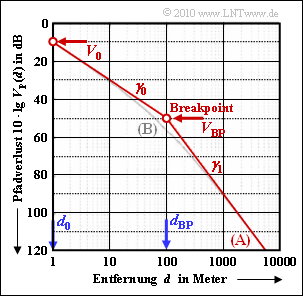Exercise 1.1: Dual Slope Loss Model
To simulate path loss in an urban environment, the asymptotic dual-slope model is often used, which is shown as a red curve in the diagram. This simple model is characterized by two linear sections separated by the so-called breakpoint (BP):
- For $d \le d_{\rm BP}$ and the exponent $\gamma_0$ we have:
$$V_{\rm P}(d) = V_{\rm 0} + \gamma_0 \cdot 10\,{\rm dB} \cdot {\rm lg} \hspace{0.15cm} ({d}/{d_0})\hspace{0.05cm}.$$
- For $d > d_{\rm BP}$ we must apply the path loss exponent $\gamma_1$ where $\gamma_1 > \gamma_0$ :
$$V_{\rm P}(d) = V_{\rm BP} + \gamma_1 \cdot 10\,{\rm dB} \cdot {\rm lg} \hspace{0.15cm} ({d}/{d_{\rm BP}})\hspace{0.05cm}.$$
In these equations, the variables are:
- $V_0$ is the path loss (in dB) at $d_0$ (normalization distance).
- $V_{\rm BP}$ is the path loss (in dB) at $d=d_{\rm BP}$ ("Breakpoint").
The graph applies to the model parameters
$$d_0 = 1\,{\rm m}\hspace{0.05cm},\hspace{0.2cm}d_{\rm BP} = 100\,{\rm m}\hspace{0.05cm},\hspace{0.2cm}
V_0 = 10\,{\rm dB}\hspace{0.05cm},\hspace{0.2cm}\gamma_0 = 2 \hspace{0.05cm},\hspace{0.2cm}\gamma_1 = 4 \hspace{0.3cm}
\Rightarrow \hspace{0.3cm}
V_{\rm BP} = 50\,{\rm dB}\hspace{0.05cm}.$$
In the questions, this piece-wise defined profile is called $\rm A$.
The second curve is the profile $\rm B$ given by the following equation: $$V_{\rm P}(d) = V_{\rm 0} + \gamma_0 \cdot 10\,{\rm dB} \cdot {\rm lg} \hspace{0.1cm} \left ( {d}/{d_0} \right ) + (\gamma_1 - \gamma_0) \cdot 10\,{\rm dB} \cdot {\rm lg} \hspace{0.1cm} \left (1 + {d}/{d_{\rm BP}} \right )\hspace{0.05cm}.$$
With this dual model, the entire distance course can be written in closed form, and the received power depends on the distance $d$ according to the following equation:
- $$P_{\rm E}(d) = \frac{P_{\rm S} \cdot G_{\rm S} \cdot G_{\rm E} /V_{\rm zus}}{K_{\rm P}(d)} \hspace{0.05cm},\hspace{0.2cm}K_{\rm P}(d) = 10^{V_{\rm P}(d)/10} \hspace{0.05cm}.$$
Here, all parameters are in natural units (not in dB). The transmit power is assumed to be $P_{\rm S} = 5 \ \rm W$ . The other quantities have the following meanings and values:
- $10 \cdot \lg \ G_{\rm S} = 17 \ \rm dB$ (gain of the transmit antenna),
- $10 \cdot \lg \ G_{\rm E} = -3 \ \ \rm dB$ (gain of receiving antenna – so actually a loss),
- $10 \cdot \lg \ V_{\rm zus} = 4 \ \ \rm dB$ (loss through feeds).
Notes:
- This task belongs to the chapter Distanzabhängige Dämpfung und Abschattung.
- If the profile $\rm B$ were
$$V_{\rm P}(d) = V_{\rm 0} + \gamma_0 \cdot 10\,{\rm dB} \cdot {\rm lg} \hspace{0.15cm} \left ( {d}/{d_0} \right ) + (\gamma_1 - \gamma_0) \cdot 10\,{\rm dB} \cdot {\rm lg} \hspace{0.1cm} \left ({d}/{d_{\rm BP}} \right )$$
- then profile $\rm A$ and profile $\rm B$ for $d ≥ d_{\rm BP}$ would be identical
- In this case, however, profile $\rm B$ would be above profile $\rm A$ for $(d < d_{\rm BP})$ , suggesting clearly too good conditions. For example, $d = d_0 = 1 \ \ \rm m$ with the given numerical values gives a result that is $40 \ \ \rm dB$ too good:
$$V_{\rm P}(d) = V_{\rm 0} + \gamma_0 \cdot 10\,{\rm dB} \cdot {\rm lg} \hspace{0.1cm} \left ( {d}/{d_0} \right ) + (\gamma_1 - \gamma_0) \cdot 10\,{\rm dB} \cdot {\rm lg} \hspace{0.1cm} \left ({d}/{d_{\rm BP}} \right ) =10\,{\rm dB} + 2 \cdot 10\,{\rm dB} \cdot {\rm lg} \hspace{0.1cm} \left ({1}/{100} \right ) = -30\,{\rm dB} \hspace{0.05cm}. $$
Questionnaire
Sample solution
(2) With the profile (B) on the other hand, using $V_0 = 10 \ \rm dB$, $\gamma_0 = 2$ and $\gamma_1 = 4$: $$V_{\rm P}(d = 100\,{\rm m}) = 10\,{\rm dB} + 20\,{\rm dB}\cdot {\rm lg} \hspace{0.1cm}(100)+ 20\,{\rm dB}\cdot {\rm lg} \hspace{0.1cm}(2) \hspace{0.15cm} \underline{\approx 56\,{\rm dB}} \hspace{0.05cm}.$$
(3) The antenna gains from the transmitter $(+17 \ \ \rm dB)$ and receiver $(-3 \ \rm dB)$ and the internal losses of the base station $(+4 \ \rm dB)$ can be combined to $$10 \cdot {\rm lg}\hspace{0.1cm} G = 10 \cdot {\rm lg}\hspace{0.1cm} G_{\rm S} + 10 \cdot {\rm lg} \hspace{0.1cm} G_{\rm E} - 10 \cdot {\rm lg}\hspace{0.1cm} V_{\rm zus} = 17\,{\rm dB} -3\,{\rm dB} - 4\,{\rm dB} = 10\,{\rm dB} \hspace{0.3cm} \Rightarrow \hspace{0.3cm} {G = 10} \hspace{0.05cm}.$$
- For the profile '(A) the following path loss occurred:
$$V_{\rm P}(d = 100\,{\rm m})\hspace{0.05cm} {= 50\,{\rm dB}} \hspace{0.3cm} \Rightarrow \hspace{0.3cm} K_{\rm P} = 10^5 \hspace{0.05cm}.$$
- This gives you \ \ \rm m$ for the receiving power after $d = 100:
$$P_{\rm E}(d = 100\,{\rm m}) = \frac{P_{\rm S} \cdot G}{K_{\rm P}} = \frac{5\,{\,} \cdot 10}{10^5}\hspace{0.15cm} \underline{= 0.5\,{\rm mW}} \hspace{0.05cm}.$$
- For profile '(B) the receiving power is about $4$ less:
- $$P_{\rm E}(d = 100\,{\rm m}) = \frac{5\,{\rm W} \cdot 10}{10^{5.6}}\approx \frac{5\,{\rm W} \cdot 10}{4 \cdot 10^{5}}\hspace{0.15cm} \underline{= 0.125\,{\rm mW}} \hspace{0.05cm}.$$
(4) Below the breakpoint $(d < 100 \ \rm m)$ the deviation is determined by the last summand of profile (B): $${\rm \delta}V_{\rm P}(d = 50\,{\rm m}) = (\gamma_1 - \gamma_0) \cdot 10\,{\rm dB} \cdot {\rm lg} \hspace{0.1cm} \left (1 + {d}/{d_{\rm BP}} \right )= (4-2) \cdot 10\,{\rm dB} \cdot {\rm lg} \hspace{0.1cm} (1.5)\hspace{0.15cm} \underline{\approx 3.5\,{\rm dB}} \hspace{0.05cm}.$$
'(5) Here the profile (A) with $V_{\rm BP} = 50 \ \rm dB$: $$V_{\rm P}(d = 200\,{\rm m}) = 50\,{\rm dB} + 4 \cdot 10\,{\rm dB} \cdot {\rm lg} \hspace{0.1cm} (2)\hspace{0.15cm} {\approx 62\,{\rm dB}} \hspace{0.05cm}.$$
- On the other hand, the profile '(B) leads to the result:
$$V_{\rm P}(d = 200\,{\rm m}) = 50\,{\rm dB} + 20\,{\rm dB} \cdot {\rm lg} \hspace{0.1cm} (200) + 20\,{\rm dB} \cdot {\rm lg} \hspace{0.1cm} (3) = 10\,{\rm dB} + 46\,{\rm dB} + 9.5\,{\rm dB} \hspace{0.15cm} {\approx 65.5\,{\rm dB}}$$ $$\Rightarrow \hspace{0.3cm} {\rm \delta}V_{\rm P}(d = 200\,{\rm m}) = 65.5\,{\rm dB} - 62\,{\rm dB}\hspace{0.15cm} \underline{\approx 3.5\,{\rm dB}} \hspace{0.05cm}.$$
- You can see that $\Delta V_{\rm P}$ is almost symmetrical to $d = d_{\rm BP}$ if you plot the distance $d$ logarithmically as in the given graph.
